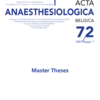The use of prophylactic corticosteroids to reduce post-extubation stridor in pediatric patients: a systematic review
steroids; airway extubation; laryngeal edema; pediatric
Published online: Apr 21 2022
Abstract
The incidence of extubation failure ranges from 4 to 68,75% in pediatric population in the intensive care unit (ICU). Extubation failure and the need for reintubation are correlated with increased morbidity, mortality and higher costs. Multiple studies investigated the efficacy of corticosteroids (CS) to prevent post- extubation stridor (PES), mainly in adults. Due to the differences in laryngeal anatomy between children and adults, children may be more prone to PES. There is still no consensus about the prophylactic use of CS for PES in children. We conducted a systematic review to collect the evidence.
We searched three different databases: MEDLINE, EMBASE and Cochrane library. The following terms: “pediatric”, “extubation”, “laryngeal edema” and “cor- ticosteroids” were searched in title and abstract.
1097 references were collected and 201 references met the criteria for full text review. Finally, nine randomized controlled trials (RCT’s) were included, enrolling 23 to 153 patients. There was a considerable heterogeneity in design, and all studies had a moderate to high risk of bias. Five RCT’s showed a significantly lower incidence of PES or extubation failure by CS treatment. Reported adverse effects of CS were low. We conclude that CS may be effective and safe to reduce post-extubation stridor in children, although the level of evidence is low.
